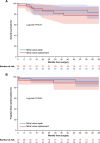Clinical outcomes after implantation of a sutureless aortic bioprosthesis with concomitant mitral valve surgery: the SURE-AVR registry
- PMID: 34053453
- PMCID: PMC8165775
- DOI: 10.1186/s13019-021-01523-w
Clinical outcomes after implantation of a sutureless aortic bioprosthesis with concomitant mitral valve surgery: the SURE-AVR registry
Abstract
Background: Early treatment of aortic valve stenosis is recommended in eligible symptomatic patients with severe aortic valve stenosis who would otherwise have a poor prognosis. The sutureless aortic valve bioprosthesis offers an alternative to standard aortic valve replacement with a sutured valve, but limited data are available in patients who have undergone multiple valve procedures involving the new, sutureless technology. We sought to investigate outcomes in high operative risk patients with previous or concomitant valve surgery who were implanted with a sutureless valve.
Methods: SURE-AVR is an ongoing, prospective, multinational registry of patients undergoing aortic valve replacement. In-hospital and post-discharge outcomes up to 5 years were collected.
Results: The study population comprised 78 patients (mean ± SD: age 73.6 ± 7.6 years, logistic EuroSCORE 18.0 ± 17.5) enrolled at 13 sites who presented for concomitant or previous mitral valve repair (n = 45) or replacement (n = 33), with or without additional concomitant procedures, and were implanted with a sutureless valve. Mean ± SD overall aortic cross-clamp time was 109 ± 41 min and cardiopulmonary bypass time was 152 ± 49 min. Mean ± SD aortic pressure gradients decreased from 37.6 ± 17.7 mmHg preoperatively to 13.0 ± 5.7 mmHg at hospital discharge, and peak aortic pressure gradient from 61.5 ± 28.7 to 23.4 ± 10.6 mmHg. Early events included 1 death, 1 transient ischaemic attack, and 1 bleed (all 1.3%); a permanent pacemaker implantation was required in 6 patients (7.7%), and 2 reoperations (not valve related) (2.6%) took place. Over a median follow-up of 55.5 months (Q1 13.4, Q3 68.6), 12 patients died (6 cardiovascular and 6 non-cardiovascular, both 2.1% per patient-year). Five-year survival was 81.3%. Late paravalvular leak occurred in 2 patients (0.7% per patient-year) and permanent pacemaker implantation was required in 3 patients (0.1% per patient-year). There was no apparent rise in mean or peak aortic pressure gradient over the study.
Conclusions: These results suggest that the sutureless implant is a technically feasible procedure during mitral surgery and is associated with good clinical outcomes.
Keywords: Aortic valve; Aortic valve replacement; Aortic valve stenosis; Valvular disease.
Conflict of interest statement
Max Baghai, Mattia Glauber, Gianluigi Bisleri, George Asimakopoulos, and Marco Solinas are proctors for LivaNova. The other authors declare they have no competing interests.
Figures
References
-
- Flameng W, Herregods MC, Hermans H, Van der Mieren G, Vercalsteren M, Poortmans G, et al. Effect of sutureless implantation of the Perceval S aortic valve bioprosthesis on intraoperative and early postoperative outcomes. J Thorac Cardiovasc Surg. 2011;142(6):1453–1457. doi: 10.1016/j.jtcvs.2011.02.021. - DOI - PubMed
-
- Pollari F, Santarpino G, Dell'Aquila AM, Gazdag L, Alnahas H, Vogt F, et al. Better short-term outcome by using sutureless valves: a propensity-matched score analysis. Ann Thorac Surg. 2014;98(2):611–6; discussion 616-7. 10.1016/j.athoracsur.2014.04.072. - PubMed
-
- Concistre G, Miceli A, Marchi F, Farneti P, Chiaramonti F, Solinas M, et al. Short-term follow up with the 3f Enable aortic bioprosthesis: clinical and echocardiographic results. J Heart Valve Dis. 2013;22(6):817–23. - PubMed
MeSH terms
LinkOut - more resources
Full Text Sources
Other Literature Sources



